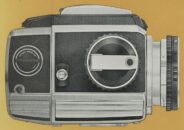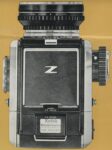Bronica S
Medium format MF film SLR camera
Specification
| Production details: | |
| Announced: | April 1961 |
| System: | ● Bronica (1959) |
| Format: | |
| Maximum format: | Medium format 6x6 |
| Film type: | 120 roll film |
| Mount and Flange focal distance: | Bronica [102mm] |
| Shutter: | |
| Type: | Focal-plane |
| Model: | Mechanical |
| Speeds: | 1 - 1/1000 + B, T |
| Exposure: | |
| Exposure metering: | None |
| Exposure modes: | Manual |
| Physical characteristics: | |
| Weight: | 1165g |
| Dimensions: | 100x100x140mm |
Manufacturer description #1
Beautiful, Isn't It?
And why not? What is more beautiful than quality? What is more beautiful than the artistry, the skill and precision evident in fine craftsmanship?
Everything about the Bronica S attests to such quality. It is a brilliantly engineered instrument; equipped with incomparable Nikkor optics. It is as smooth and responsive as a fine '35' - incredibly versatile, fast and easy to handle.It is as much at home on location as in the studio, hand-held or on a tripod. There isn't an assignment it cannot handle.
Moreover, the Bronica S is ingeniously automatic - an automatic 2 1/4 square single lens reflex with automatic return mirror, automatic reopen diaphragm and depth-of-field preview control.
The crank which advances the film simultaneously winds the shutter. An automatic tension system holds the film flat and taut for the exposure.
The Bronica S permits you to interchange films by simply switching film backs, at any time. The Filminder feature automatically protects the film. You cannot, for example, inadvertently double-expose or wind off unexposed film, or fire the shutter unless the dark-slide is withdrawn.
The Bronica S accepts interchangeable Nikkor lenses from 50mm wide angle to 500mm telephoto, and a variety of accessories; extension tubes and focusing bellows for close-ups; prism finders for eyelevel focusing; lens adapters; hand grip; filters; lens hoods; and a luxurious compartment case.
$419.50 with 75mm Auto-Nikkor f2.8 lens.
Manufacturer description #2
Bronica has captured the feel of the fine '35'
Bronica captured the responsiveness of the fine '35' and brought it to the 2 1/4 square format. It captured the handling ease, the speed and precision, and embodied them in the Bronica S. And it then equipped the Bronica S with incomparable Nikkor optics.
Everything about the S attests to quality. Brilliantly engineered and incredibly versatile, it is as much at home on location as in the studio, hand-held or on a tripod. There isn't a picture problem it can't handle.
The Bronica S is ingeniously automatic, provided with automatic-return mirror, automatic-reopen diaphragm and depth-of-field preview control. The crank which advances the film simultaneously winds the shutter. And an automatic tension system holds the film flat and taut for each exposure.
The Bronica S permits you to interchange films by simply switching film backs, at any time. And its Filminder feature automatically protects the film. You cannot, for example, inadvertently double-expose or wind-off unexposed film, and you cannot fire the shutter unless the dark slide is completely withdrawn.
The Bronica S accepts interchangeable Nikkor lenses from 50mm wide angle to 500mm telephoto, and a variety of accessories; extension tubes and focusing bellows for close-ups; prism finders for eyelevel focusing; lens adapters; hand grip; filters; lens hoods; and a luxurious compartment case.
The Bronica S is priced at $419.50 with 75mm Auto-Nikkor f2.8 lens.
Manufacturer description #3
Here is the exciting new single lens reflex that has successfully combined the big 2 1/4 inch format with the handling ease, speed and versatility of a fine '35'. The Bronica S is a totally new kind of camera, so original in concept, it took more than seventy-seven patents to cover its design.
The Bronica-S is the only automatic 2 1/4 square reflex in the field, the only reflex with interchangeable Nikkor lenses as standard equipment. Here are some of its features:
- Instant-Return Automatic Mirror - Finder image never blacks out. Mirror returns instantly to viewing position.
- Instant-Reopen Automatic Diaphragm - Finder image never dims, Diaphragm reopens instantly after exposure.
- Independent Mirror Release - Permits use of shutter-mounted lenses. Also desirable for long-duration exposures.
- Depth-of-Field Preview Button - You see depth-of-field at 'taking' aperture, or select aperture for depth desired.
- Interchangeable Nikkor Lenses - Accepts 7 Nikkors now available from 50mm wide angle to 500m telephoto.
- Interchangeable Filminder Backs - You can switch film at any time. Prevents accidental exposures and 'blanks'.
- Rapid Transport Crank - Advances film and winds shutter. Folds flush into focusing knob when not in use.
- Automatic film-flatness system - Tension device holds film flat for exposure. Relaxes while film is advanced.
- Focal Plane Shutter - Gives you any speed from 1 second to 1/1000th, FP, M and X synchronization provided.
- Accessories Include: eyelevel prism finders, extension tubes, lens adapters, filters, lens hoods and cases.
Manufacturer description #4
BRONICA "S"
This is the second model introduced by Bronica. It was available in chrome only and can be identified as follows:
1. Fixed, non-removable chrome focusing mount.
2. PC contact on front of body.
3. Mirror lock w/switch below shutter release.
4. Distance scale and focus control on ring around advance crank.
S. Speed dial on left side of body.
The S model was introduced while the DeLuxe was still in production and represented a simplified version of that camera. Top speed was lowered to 1/1000 second and the self-timer/long exposure control, double exposure control and focus lock were eliminated.
LENSES AND ACCESSORIES
All Small bayonet mount Bronica Nikkor lenses fit the S body. The 105mm F3.5 Nikkor and 300mm F4.5 Zenzanon will not fit. A special focusing mount adapter for tele-Nikkor lenses was made for the S fixed mount, but was not sold in the U.S. The present focusing tube will not fit the S camera. This model also requires a special extension tube set and bellows. The current tubes and bellows do not fit the S mount.
All prisms, hoods and grips as well as the sportsfinder for the present S2A will fit the S.
Manufacturer description #5
INSTANT RETURN AUTOMATIC MIRROR
The reflex mirror of the BRONICA S is on exclusive original. It does not fiip up for the exposure as in other single lens reflex cameras, but it moves forward and down with greater clearance provided for deep seated lenses permitting shorter focal length to be used without mirror interference. Using this exclusive method, the BRONICA S can be equipped with a normal 75mm lens or with a 50mm super wide angle. After on exposure, the mirror instantly automatically returns to viewing position.
INSTANT REOPEN AUTOMATIC DIAPHRAGM
Lenses for the BRONICA S have fully automatic diaphragms. Simply focus and view with the lenses wide open. When an exposure is made, the diaphragm automatically closes down to the preselected aperture for the correct exposure. Immediately after the exposure, the diaphragm automatically reopens to full aperture to provide a bright clear image on the focusing screen - ready for the next picture with no readjustment.
DEPTH-OF-FIELD PREVIEW BUTTON
The lens on the BRONICA S is always wide open for focusing and viewing. This provides maximum image-screen brightness for greater ease and accuracy. However it is often desirable to see the depth-of-field at 'taking' aperture. This is done by pressing the Depth-of-Field Preview Button. The diaphragm automatically stops down. Release the button and the diaphragm instantly returns to full aperture.
INTERCHANGEABLE 'FILMINDER' BACK
This convenient feature offers mony advantages. It is possible to change fiIm in the middle of a roll (black-and-white to color, color to black-and-white, indoor to daylight, etc.) without the loss of a single exposure. It permits you to preload several backs and shoot continuously without stopping for reloads.
The filminder back is fully automatic and foolproof. It is equipped with a metal dark slide to prevent the film from being exposed while the back is off the camera. The back cannot be removed until the dark slide is inserted and while the back is off the camera, the dark slide cannot be withdrawn.
When a filminder back is attached to the camera, no attention need be paid as to whether the film or the shutter has been previously wound.
The film advance crank, which normally winds the shutter and the film simultaneously, automatically performs only the required function. For example, if the shutter is wound and if the film in position has been exposed, turning the crank will only advance the film to a fresh unexposed section. Also, when the back is on the camera, the dark slide must be completely withdrawn before an exposure can be made.
NEW EXCLUSIVE FILM TENSION SYSTEM
The BRONICA film tension system makes the film surface perfectly flat at the focal plane. All tension on the film is removed during the winding process. The instant the film is in place, tension is automatically applied.
The system not only adds much greater tension on the film during exposure to assure perfect film flatness but also eliminates dangerous film scratches which occur if the film is advanced while under tension.
NIKKOR LENSES
Nikkor lenses are standard for the BRONICA S. Today, no finer optics are available. Nikkor lenses are the most compatible for the superb performance of the BRONICA S. They have proved to be the finest in the 35mm photography field in which optical quality means almost everything.
The available focal lengths range from 50mm super wide angle to 200mm telephoto. The 50, 75, 135, and 200mm lenses are equipped with instant reopen automatic diaphragms and are designated as Auto-Nikkors.
***
TYPE: Daylight loading, interchangeable film back, 2 1/4 X 2 1/4" (6cm X 6cm) single lens reflex camera.
FILM: 120 roll film, 12 exposures.
STANDARD LENS: Nikkor 75mm F:2.8 fully automatic preset diaphragm, 5 elements.
LENS MOUNT: Bayonet type (BRONICA mounting), also equipped with screw mounting (57mm dia. X 1mm pitch), large bayonet mounting for long telephoto lenses.
FINDER: Fresnel lens and large magnifier.
VIEWFINDER HOOD: Interchangeable with pentaprism viewfinder, sports finder or magnifying hood.
FOCUSING: Side knob type.
DISTANCE SCALE: For 75mm, 50mm and 135mm lenses.
MIRROR: Flip down, instant return, automatic mirror system.
MIRROR LOCK DOWN: Mirror can be locked down in a separate action.
DIAPHRAGM: Fully automatic diaphragm - 75mm, 50mm, 135mm and 200mm lenses.
DEPTH-OF-FIELD PREVIEW: Depth-of-field can be checked by pressing preview button.
SHUTTER: Vertically operating focal plane shutter, non-rotating single shutter dial, B, 1, 1/2, 1/4, 1/8, 1/15, 1/30, 1/60, 1/125, 1/250, 1/500, 1/1000 and "X" (1/50), "T" (Time) exposure by using shutter release lock device. Intermediate shutter speeds.
SYNCHRO: Automatic switch-over synchronization system: FP class bulb: synchronized at all shutter speeds except "X". M class bulb: B, 1-1/125. F class bulb: B, 1-1/15. Electronic Flash: "X". 1-1/15.
INTERCHANGING FILMS: Interchangeable film back fully coupled with camera body, dark slide with safety lock system, built-in light leak prevention curtain.
FILM LOADING: Separate film holder, automatic film winding system by matching with film start mark.
FILM WINDING: Winding crank.
FILM COUNTER: Automatically returns to "0".
EXTERIOR CAMERA BODY: Made of 18-8 Stainless Steel, bright polished finish.


